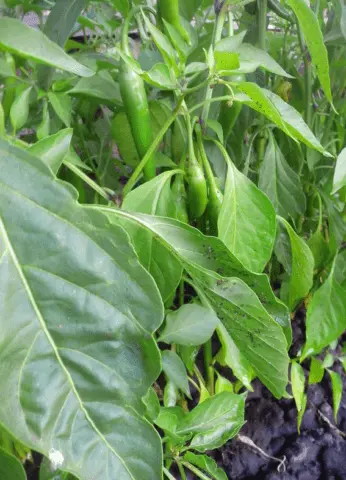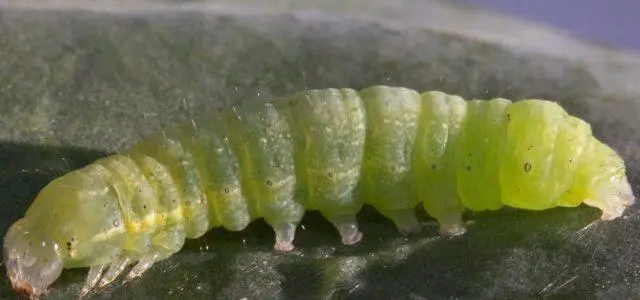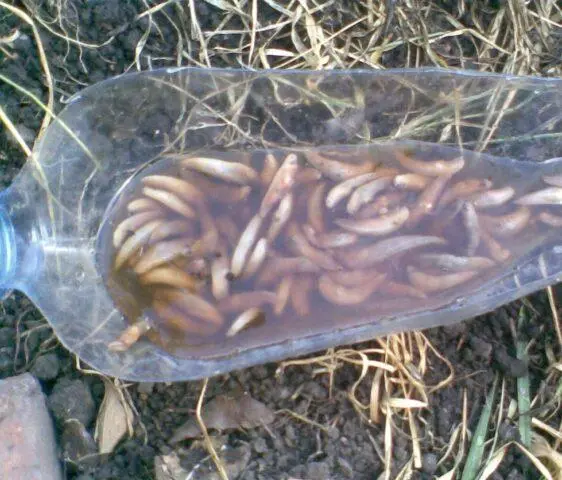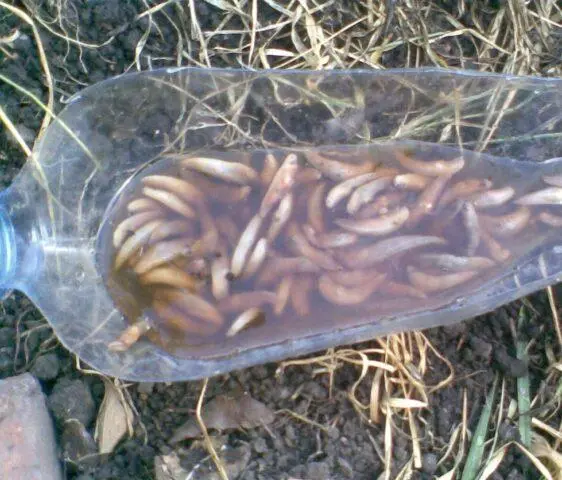Contents
Holes on pepper leaves appear when grown both in open ground and in a greenhouse. They are gnawed by insects (aphids, Colorado potato beetles) or slugs. Because of this, the bushes weaken, the leaves gradually dry out, which is bad for the yield. If the invasion is very strong, it is necessary to use chemicals. In other cases, folk remedies show a good result – infusions, decoctions or solutions.
Why do holes appear on pepper leaves?
If holes appear on pepper leaves, first of all, you need to carefully examine the plantings, including neighboring crops. The main reason for the appearance of holes is leaf-eating pests. Among them can be both insects (aphids, Colorado potato beetle, scoop caterpillars) and molluscs (slugs).
aphid

Aphids are a dangerous pest that appears not only on peppers, but also on other plants.
The insect is very prolific, giving more than 10 generations during the season. It can be detected visually – a colony of small dots of brown, black, greenish hue is visible from the underside of the leaves.
There are other signs of the appearance of aphids on pepper:
- deformation of apical shoots;
- weakened appearance, developmental delay;
- whitish sticky coating on leaves and branches;
- small holes.
When an anthill is found, it must be destroyed or doused with boiling water. Otherwise, aphids will multiply, which will cause many holes to appear on the leaves.
Colorado beetle
The Colorado potato beetle can also be detected visually. Its body has a noticeable color – black stripes on a light yellow background. The danger to pepper is not only adults, but also larvae. In the early stages, they are light gray in color, and then red-yellow. The body is fleshy, somewhat reminiscent of a worm.

The female Colorado potato beetle leaves a clutch of eggs on the underside of a leaf.
Pests begin to eat plant tissues immediately after transplanting seedlings into open ground and until the end of fruiting in August. Their accumulations can be seen on any part of the culture. As a result, holes appear on the foliage, the surface becomes damaged, which is bad for productivity.
Slugs
Slugs are a type of mollusc without hard shells. They are called so because they stain everything with special mucus, with the help of which I can quickly move along leaves, stems and other surfaces.

The body of the slug is large, easily visible even at a distance.
The shape of the pest is worm-like, coloring from sandy and orange to brown, gray and black. Slugs are distributed almost everywhere. Favorable conditions for their appearance are high humidity, warm weather and the ability to hide in cracks, the surface layer of soil and other shelters. They are active at night, always hiding in the morning. They eat leaves, leave holes.
In this case, the most likely cause is larvae of slugs that spread with the ground. They are active at night, and during the day they hide in the surface layer of the soil.
Scoop caterpillars
Also, holes in pepper leaves may appear due to scoop caterpillars. These are leaf-eating insects with a rather large, clearly visible green body with gray speckles on the sides. Hiding along the stems, as well as in the leaf axils.
It feeds on plant juices, gnaws holes, which leads to the gradual death of the leaves. If the invasion is strong, the crop will suffer significantly, so the caterpillars should be harvested by hand as soon as possible, and then processed.

Caterpillars are easy to spot and remove by hand
Pepper pests in the greenhouse
Pepper is a demanding plant, so it is often grown in a greenhouse. In a greenhouse, the following insects are of particular danger:
- aphid;
- bear;
- thrips;
- Colorado beetle
- spider mite;
- nematodes.
Not all of them gnaw holes in leaf plates. But the described pests are dangerous, prolific and can easily move to neighboring plants. It is also worth considering that in the greenhouse they feel especially comfortable due to the high humidity and the absence of strong temperature changes.
Outdoor Pepper Pests
When grown outdoors, peppers are at risk from the same pests. But other representatives can be added to them:
- May beetle (including larvae);
- wireworm;
- slippery;
- whitefly.
When growing crops in open beds, it is worth remembering that seedlings are practically not protected by anything. They can suffer not only from pests, but also from adverse weather conditions, for example, night cold snaps, strong winds or scorching sun.
How to process pepper if holes appear on its leaves
If holes appear on the leaves on seedlings or adult pepper bushes, you must immediately begin processing. At the same time, large pests (Colorado beetles, slugs) are first removed by hand, collected in a cage and then destroyed. After this, the landings are totally processed using chemicals. In the early stages, it is permissible to use folk methods.
Chemicals
Chemicals are the most effective way to control pests that gnaw holes in pepper leaves. However, they have a drawback – not all drugs are safe for humans, pets and beneficial insects. Therefore, processing must be planned in advance, observing waiting times, i.e. minimum number of days before harvest.

“Biotlin” – one of the popular chemicals against aphids
The most effective insecticides against insects that leave holes in pepper leaves include:
- “Aktara”;
- “Biotlin”;
- “Batrider”;
- “Tanrek”;
- “Chistosvet” and others.
The Colorado potato beetle, which gnaws holes on pepper leaves, is fought with the help of such drugs:
- “Arrivo”;
- “Karate”;
- “Alfas”;
- “Spark”;
- “Shar pei”.
From scoops that gnaw holes on the surface of pepper leaves, the following remedies help well:
- “Confidor”;
- “Decis”;
- “Agravertin”;
- Carbophos;
- Fitoverm.
As for the slugs, which not only make holes on the pepper leaves, but also almost completely destroy them, the following preparations help to cope with them:
- “Thunderstorm”;
- “Ulicide”;
- “Slug” and others.
Spraying with insecticides, acaricides and other preparations against insects that leave holes on pepper leaves is carried out in the evening, preferably in dry and calm weather (if plantings are made in open ground). The solution is obtained according to the instructions, after which one or a maximum of two treatments are carried out. You can start harvesting no earlier than in 10-15 days (there are longer waiting periods – up to 30 days).
Folk methods
Folk remedies against pests that gnaw holes on pepper leaves work well in the early stages of the invasion and during fruiting, when some chemicals can be dangerous. They are also used for prevention.
The recipes are quite simple. It is necessary to make a decoction, infusion or solution. Among the most effective remedies recommended by experienced gardeners are the following (the amount of raw materials is indicated for a standard bucket of water – 10 liters):
- A decoction of tomato or potato tops – 500 g.
- A decoction of marigold flowers – 500 g.
- Infusion of wormwood, dandelions, celandine (separately) – 500 g.
- Infusion of wood ash – 200 g.
- Hydrogen peroxide solution – 2 tablespoons and the same amount of laundry soap shavings.
- Infusion of tobacco dust – 200 g.
- Ammonia solution – 2 tbsp. l.
- Infusion of onion peel – 1 kg.
- Chili pepper infusion – 100 g.
- Infusion of garlic cloves – 100 g.

As a trap for slugs, you can use an ordinary plastic bottle.
The described remedies help to cope well with insects and beetles that leave holes in pepper leaves. As for slugs, they are removed manually, and the following methods are used to scare away:
- scatter broken shells of nuts or eggs next to the bed;
- sprinkle the tracks with mustard powder;
- lay out chopped chili peppers on the site;
- drop in a jar (trap) with raw paper, soil, rotten leaves.
You can also sprinkle the places of accumulation of pests with fluffy lime. But it is important to remember that it alkalizes the soil, increasing the pH. Therefore, you should not use such a tool regularly.
Preventive measures
No one is immune from the invasion of pests, but the risk of slugs, aphids, Colorado potato beetles and other pests can be completely reduced. To do this, it is recommended to follow the advice of experienced gardeners who know how to deal with holes on the leaves of seedlings and adult pepper bushes:
- Carefully remove weeds and plant debris in the fall, take them away and burn or simply throw them away.
- Dig up the area and remove weeds by crushing them with a shovel.
- Monitor the appearance of anthills and ruin them.
- Observe the watering rate, avoiding excessive moisture.
- Ventilate the greenhouse regularly, especially in the heat.
- Do not thicken plantings, even if there is not enough space.
- Remove debris, foreign objects, stones, behind which slugs, beetles and other pepper pests can hide, leaving holes on its leaves.
- Carry out preventive treatments after transplanting seedlings into a greenhouse or into open ground, using the described preparations or folk remedies.
Conclusion
Holes on pepper leaves appear even on seedlings, which are usually grown at home. But most often they are formed after transplanting into the ground or into a greenhouse. The main reason is associated with aphids, Colorado potato beetles, slugs and other pests. They can be destroyed with chemicals or products prepared according to folk recipes.









